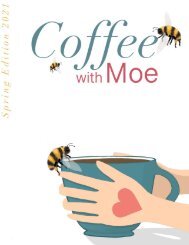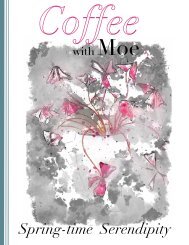Coffee with Moe - Let it Grow!
Grab a cuppa and take 5 while you sip, flip and let your mind grow full of ideas on gardening, sustainability, and more.
Grab a cuppa and take 5 while you sip, flip and let your mind grow full of ideas on gardening, sustainability, and more.
You also want an ePaper? Increase the reach of your titles
YUMPU automatically turns print PDFs into web optimized ePapers that Google loves.
It may seem a l<strong>it</strong>tle strange for me to be<br />
talking about lawns. Especially since<br />
about 10 years ago, I removed every<br />
blade of grass from my yard.<br />
The reason I made such a radical<br />
change, began when researching<br />
how to resurrect the sad l<strong>it</strong>tle lawn I’d<br />
inher<strong>it</strong>ed <strong>w<strong>it</strong>h</strong> my house. I found that<br />
tens of millions of pounds in pesticides,<br />
hundreds of millions of gallons of gas<br />
and trillions of gallons of water were/<br />
are being used to maintain lawns per<br />
year? Impact from run off into our<br />
water systems and drinking water not<br />
to mention air born pollutants stacked<br />
up to a whole lot of environmental<br />
concerns. The idea of ripping the whole<br />
lawn out for a reboot seemed beyond<br />
a sustainable solution, <strong>it</strong> seemed<br />
downright sensible.<br />
Fast forward ten years and we still<br />
find plenty of lawns subjected to the<br />
“fast and easy” chemically supported<br />
method of care. The good news is,<br />
this doesn’t have to be the way <strong>it</strong> is.<br />
W<strong>it</strong>h a growing global focus on the<br />
environment, companies are starting to<br />
see a monetary benef<strong>it</strong> to bringing back<br />
more eco-friendly forms of lawn care.<br />
You see <strong>it</strong>’s not that our lawns need<br />
chemicals, <strong>it</strong>’s just that we’ve been<br />
marketed that this is the only way they<br />
will thrive.<br />
(If you can’t live <strong>w<strong>it</strong>h</strong>out your lawn,<br />
this part is for you!)<br />
When lawns first became a thing,<br />
lawn seed packages contained more<br />
than just lawn seed? It’s true. Clover<br />
(a n<strong>it</strong>rogen fixer), tiny flowers to feed<br />
the bees and other beneficial plants<br />
to reduce soil compaction used to<br />
naturally be part of each lawns ecosystem.<br />
These add<strong>it</strong>ional plants helped<br />
keep lawns and soil healthier <strong>w<strong>it</strong>h</strong> a<br />
side benef<strong>it</strong> of assisting bio-divers<strong>it</strong>y by<br />
creating a lush oasis of food for birds,<br />
bees and butterflies while providing a<br />
healthy playground for our l<strong>it</strong>tle ones<br />
(children and pets alike)<br />
Those days aren’t beyond us.<br />
Companies are now seeing the value<br />
of selling alternative lawn options<br />
that require less water, less mowing<br />
and no pesticides.<br />
Things, <strong>it</strong> seems, are coming full circle.<br />
Many seed companies are now offering<br />
eco-friendly seed mixes to combat<br />
drought cond<strong>it</strong>ions, soil recovery and<br />
are as easy to use as overseeding the<br />
lawn you already have in place.<br />
It’s a win / win for lawn lovers and<br />
nature alike. It’s time we play together<br />
again.<br />
Lawn & Order

















